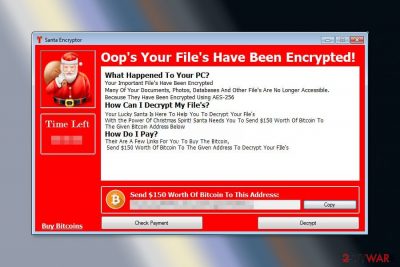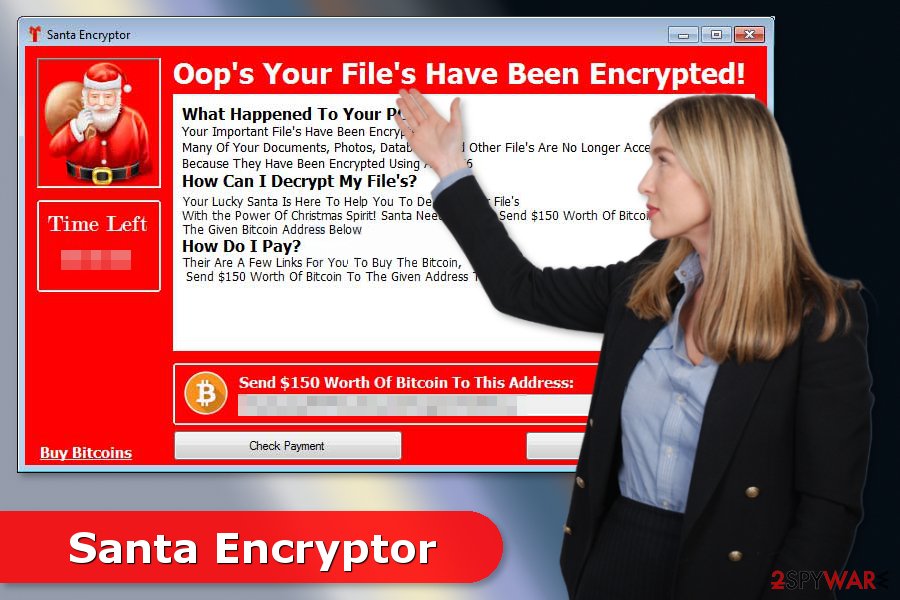Santa Encryptor ransomware (Bonus: Decryption Steps) - Dec 2017 update
Santa Encryptor virus Removal Guide
What is Santa Encryptor ransomware?
Santa Encryptor ransomware is another virus using Christmas theme

Santa Encryptor virus is a Christmas-themed ransomware virus that emerged in December 2017. In the lock screen ransom note, malware claims that files on the targeted computer are encrypted with AES-256 encryption. However, researchers tell that it might be only using XOR cryptography.
Though, the virus is still in development. However, Santa Encryptor ransomware is not the first malicious program that wants to make Christmas season terrible. Last year, the cyber community was hit by MerryChristmas ransomware that took computer users’ files to hostage too. New versions of malware were spotted this year too.[1]
According to the latest research data, Santa Encryptor is executed from ChristmasPresent.exe that might be spread as a fake program, update or malicious email attachment. Once inside, it might cause important system changes to boot with system startup, start data encryption and deliver a lock-screen message.
The ransom note imitates the design of the WannaCry; however, it has an image of the Santa Claus. It informs about data encryption and decryption, asks to send $150 to the provided Bitcoin wallet address and shows the time left for the payment:
Oop's Your File's Have Been Encrypted!
What Happened To Your PC?
Your Important File's Have Been Encrypted Many Of Your Documents, Photos, Databases And Other File's Are No Longer Accessible. Because They Have Been Encrypted Using AES-256
How Can I Decrypt My File's?
Your Lucky Santa Is Here To Help You To Decrypt Your File's With the Power Of Christmas Spirit! Santa Needs You To Send $150 Worth Of Bitcoin To The Given Bitcoin Address Below
How Do I Pay? Their Are A Few Links For You To Buy The Bitcoin, Send $150 Worth Of Bitcoin To The Given Address To Decrypt Your FIles
Send $150 Worth Of Bitcoin To This Address:
However, following the instructions appeared on the lock screen window is not recommended. The malicious program barely encrypts files at the moment. Thus, you should remove Santa Encryptor ransomware from the computer without hesitation.
Keep in mind that you are still dealing with a file-encrypting virus. Thus, you should not try to locate and eliminate ransomware-related components manually. You should complete Santa Encryptor removal with reputable malware removal software, such as FortectIntego.

Possible ways used for ransomware distribution
Cyber criminals might spread crypto-virus using:[2]
- malicious spam emails;
- fake software downloads or updates;
- illegal downloads;
- malicious ads.
These methods are widely used by other malware developers. Authors of malware apply social engineering tactics to trick people into opening obfuscated email attachment that contains malware executable or downloading fake program/update by delivering a misleading pop-up. For this reason, you should remain vigilant to avoid a cyber attack.
Malware researchers from virusi.bg[3] warn that file-encrypting viruses might also use exploit kits and take advantage of the outdated software. Thus, you should regularly update programs and operating system.
Additionally, you should still install antivirus and backup data. Modern malware is capable of bypassing even the strongest security detection. Thus, you have to be prepared for the worst.
Terminate Santa Encryptor virus and restore your files
The correct way to remove Santa Encryptor is to scan the system with FortectIntego, Malwarebytes or another malware removal tool. However, the malicious program might be designed to block security tools, so you should reboot to Safe Mode with Networking or try System Restore first (instructions below).
After Santa Encryptor removal, you should be able to restore your files using third-party recovery tools or backups. Though, if you have never backed up your data, you should do that as soon as you regain yours.
Getting rid of Santa Encryptor virus. Follow these steps
Manual removal using Safe Mode
Start your computer in Safe Mode with Networking mode to eliminate the virus without any problems:
Important! →
Manual removal guide might be too complicated for regular computer users. It requires advanced IT knowledge to be performed correctly (if vital system files are removed or damaged, it might result in full Windows compromise), and it also might take hours to complete. Therefore, we highly advise using the automatic method provided above instead.
Step 1. Access Safe Mode with Networking
Manual malware removal should be best performed in the Safe Mode environment.
Windows 7 / Vista / XP
- Click Start > Shutdown > Restart > OK.
- When your computer becomes active, start pressing F8 button (if that does not work, try F2, F12, Del, etc. – it all depends on your motherboard model) multiple times until you see the Advanced Boot Options window.
- Select Safe Mode with Networking from the list.

Windows 10 / Windows 8
- Right-click on Start button and select Settings.

- Scroll down to pick Update & Security.

- On the left side of the window, pick Recovery.
- Now scroll down to find Advanced Startup section.
- Click Restart now.

- Select Troubleshoot.

- Go to Advanced options.

- Select Startup Settings.

- Press Restart.
- Now press 5 or click 5) Enable Safe Mode with Networking.

Step 2. Shut down suspicious processes
Windows Task Manager is a useful tool that shows all the processes running in the background. If malware is running a process, you need to shut it down:
- Press Ctrl + Shift + Esc on your keyboard to open Windows Task Manager.
- Click on More details.

- Scroll down to Background processes section, and look for anything suspicious.
- Right-click and select Open file location.

- Go back to the process, right-click and pick End Task.

- Delete the contents of the malicious folder.
Step 3. Check program Startup
- Press Ctrl + Shift + Esc on your keyboard to open Windows Task Manager.
- Go to Startup tab.
- Right-click on the suspicious program and pick Disable.

Step 4. Delete virus files
Malware-related files can be found in various places within your computer. Here are instructions that could help you find them:
- Type in Disk Cleanup in Windows search and press Enter.

- Select the drive you want to clean (C: is your main drive by default and is likely to be the one that has malicious files in).
- Scroll through the Files to delete list and select the following:
Temporary Internet Files
Downloads
Recycle Bin
Temporary files - Pick Clean up system files.

- You can also look for other malicious files hidden in the following folders (type these entries in Windows Search and press Enter):
%AppData%
%LocalAppData%
%ProgramData%
%WinDir%
After you are finished, reboot the PC in normal mode.
Remove Santa Encryptor using System Restore
-
Step 1: Reboot your computer to Safe Mode with Command Prompt
Windows 7 / Vista / XP- Click Start → Shutdown → Restart → OK.
- When your computer becomes active, start pressing F8 multiple times until you see the Advanced Boot Options window.
-
Select Command Prompt from the list

Windows 10 / Windows 8- Press the Power button at the Windows login screen. Now press and hold Shift, which is on your keyboard, and click Restart..
- Now select Troubleshoot → Advanced options → Startup Settings and finally press Restart.
-
Once your computer becomes active, select Enable Safe Mode with Command Prompt in Startup Settings window.

-
Step 2: Restore your system files and settings
-
Once the Command Prompt window shows up, enter cd restore and click Enter.

-
Now type rstrui.exe and press Enter again..

-
When a new window shows up, click Next and select your restore point that is prior the infiltration of Santa Encryptor. After doing that, click Next.


-
Now click Yes to start system restore.

-
Once the Command Prompt window shows up, enter cd restore and click Enter.
Bonus: Recover your data
Guide which is presented above is supposed to help you remove Santa Encryptor from your computer. To recover your encrypted files, we recommend using a detailed guide prepared by 2-spyware.com security experts.If your files are encrypted by Santa Encryptor, you can use several methods to restore them:
Data Recovery Pro – alternative way to restore files
Nevertheless, this program was originally created for recovering files after system wreckage; victims of ransomware find it useful too.
- Download Data Recovery Pro;
- Follow the steps of Data Recovery Setup and install the program on your computer;
- Launch it and scan your computer for files encrypted by Santa Encryptor ransomware;
- Restore them.
Windows Previous Versions feature is useful if you need to restore only a few files
This Windows feature allows accessing previously saved versions of files. However, in order to copy individual entries, you should have been enabled System Restore before Santa Encryptor attack.
- Find an encrypted file you need to restore and right-click on it;
- Select “Properties” and go to “Previous versions” tab;
- Here, check each of available copies of the file in “Folder versions”. You should select the version you want to recover and click “Restore”.
ShadowExplorer recovers files from Shadow Volume Copies
Ransomware does not seem to delete shadow copies of the corrupted files. Thus, ShadowExplorer might help to recover them:
- Download Shadow Explorer (http://shadowexplorer.com/);
- Follow a Shadow Explorer Setup Wizard and install this application on your computer;
- Launch the program and go through the drop down menu on the top left corner to select the disk of your encrypted data. Check what folders are there;
- Right-click on the folder you want to restore and select “Export”. You can also select where you want it to be stored.
Santa Encryptor decryption tool is not available yet.
Finally, you should always think about the protection of crypto-ransomwares. In order to protect your computer from Santa Encryptor and other ransomwares, use a reputable anti-spyware, such as FortectIntego, SpyHunter 5Combo Cleaner or Malwarebytes
How to prevent from getting ransomware
Access your website securely from any location
When you work on the domain, site, blog, or different project that requires constant management, content creation, or coding, you may need to connect to the server and content management service more often. The best solution for creating a tighter network could be a dedicated/fixed IP address.
If you make your IP address static and set to your device, you can connect to the CMS from any location and do not create any additional issues for the server or network manager that needs to monitor connections and activities. VPN software providers like Private Internet Access can help you with such settings and offer the option to control the online reputation and manage projects easily from any part of the world.
Recover files after data-affecting malware attacks
While much of the data can be accidentally deleted due to various reasons, malware is one of the main culprits that can cause loss of pictures, documents, videos, and other important files. More serious malware infections lead to significant data loss when your documents, system files, and images get encrypted. In particular, ransomware is is a type of malware that focuses on such functions, so your files become useless without an ability to access them.
Even though there is little to no possibility to recover after file-locking threats, some applications have features for data recovery in the system. In some cases, Data Recovery Pro can also help to recover at least some portion of your data after data-locking virus infection or general cyber infection.
- ^ Bradley Barth. Yule be sorry: Belated Merry Christmas ransomware festively encrypts files, drops DiamondFox malware. SC Magazine. Breaking news on cybersecurity, cybercrime, industry insight and security product reviews.
- ^ Phil Goldstein. The 3 Main Ways Ransomware Spreads in 2017. BizTech Magazine. Latest tech news, industry coverage, and IT solutions for businesses.
- ^ Virusi. Virusi. Bulgarian cyber security news.





















